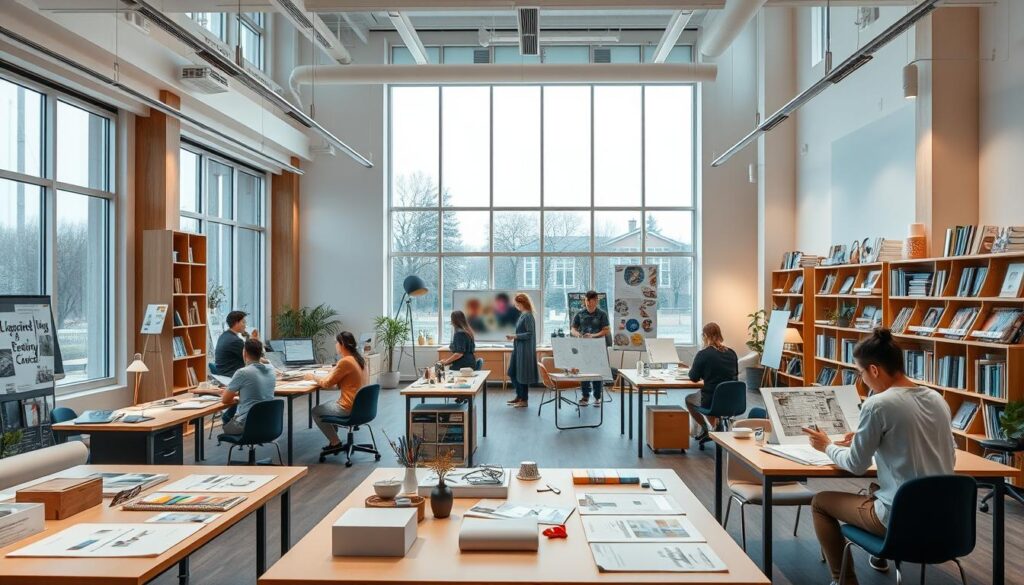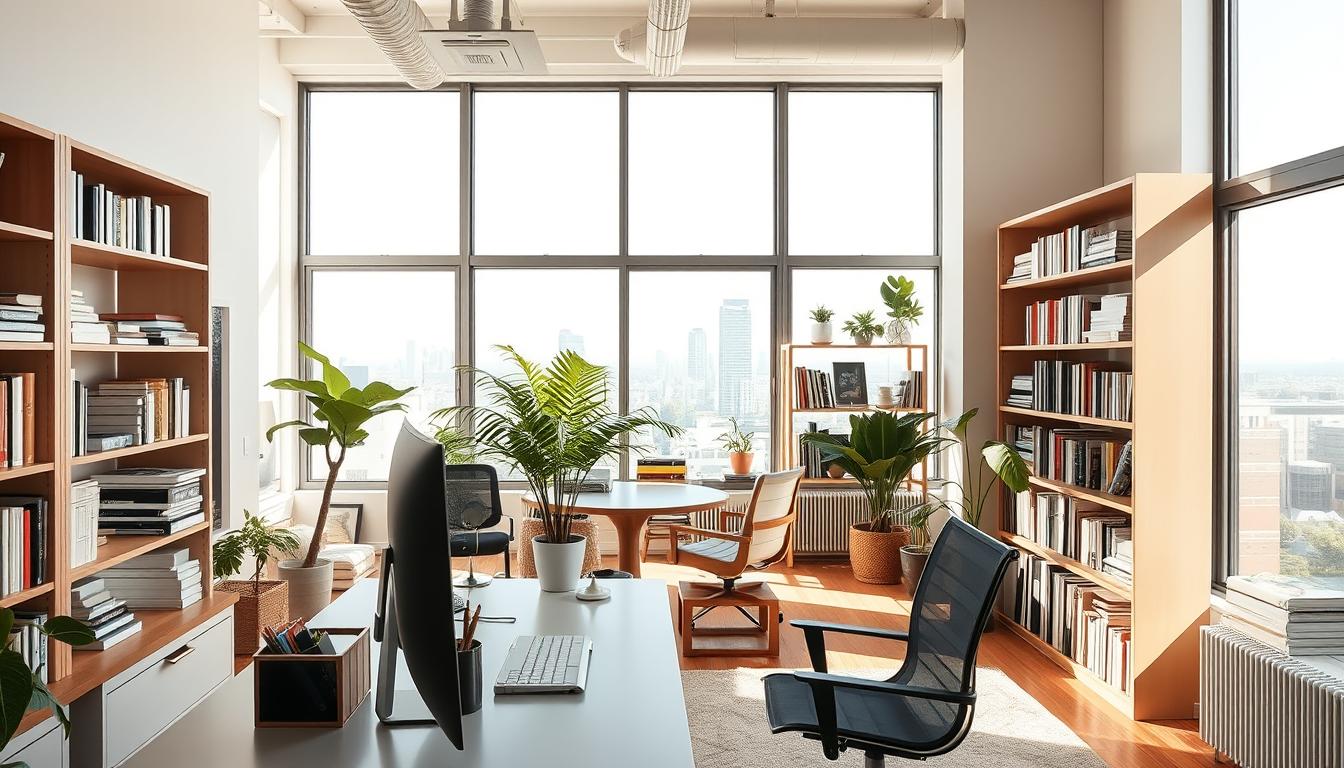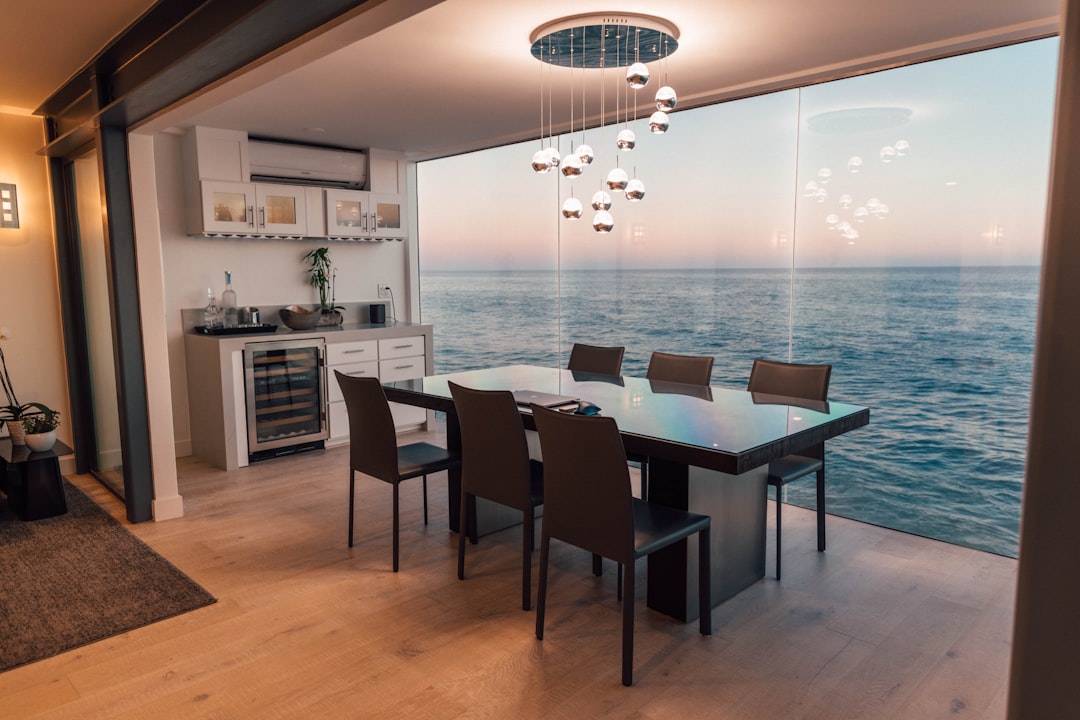Did you know the demand for interior designers is growing by 5%? This is because people want homes that are both sustainable and functional. As you start your journey to become an interior designer, finding the right tools and training is key.
There are many interior design programs out there. Choosing the best one can feel overwhelming. We’re here to help you find the top online courses, accredited schools, and certificate programs for your goals.
Whether you’re just beginning or looking to grow in your career, we’ve got you covered. We’ll give you the info you need to choose the right path for your future in interior design.
Key Takeaways
- Top interior design programs to consider for your career
- Online courses and accredited schools that offer flexible learning options
- Certificate programs that can enhance your skills and credentials
- Factors to consider when choosing the best program for your needs
- Tips for advancing your career in interior design
Understanding Interior Design Programs
Most of our lives are spent indoors. This makes interior design programs very important. They help create spaces that are not just pretty but also useful and good for our health.
What is Interior Design?
Interior design is a complex field. It involves understanding how people behave and designing spaces that work well. It also means keeping up with new trends and technologies.
It requires a mix of technical skills, like knowing building codes and materials. And creative skills, like picking colors and furniture.
Good interior design makes life better for those who use the space. It’s not just about making a room look nice. It’s about making a space that is good for the planet and meets the needs of its users.
Importance of Interior Design Education
To be a good interior designer, you need to learn a lot. Accredited interior design schools offer courses that cover everything from basic design to sustainable practices.
These programs teach students the skills they need to do well in the field. They learn about design principles and the latest technologies. This includes online interior design courses that are flexible and easy to access.
By joining an accredited interior design program, future designers can learn what they need to know. They can then make a real difference in the world of design.
Types of Interior Design Programs Available
The world of interior design education has many programs for different career goals. It’s key to know the various paths you can take in this field.
Associate Degrees
Associate degrees in interior design are a solid start, taking two years to finish. They cover the basics like space planning, color theory, and design principles. They’re great for quick entry into the job market or as a first step towards a bachelor’s degree.
Bachelor’s Degrees
Bachelor’s degrees in interior design take four years to complete. They dive deeper into design, including sustainable design practices and computer-aided design (CAD). These programs are among the top, giving students a solid grasp of the field.
Master’s Degrees
Master’s degrees in interior design are for those aiming to specialize or move up in their careers. They focus on advanced topics like design research, historic preservation, and business management. A master’s degree is great for those wanting to teach or lead design firms.
Here’s a comparison of these programs:
| Degree Level | Duration | Focus Areas |
|---|---|---|
| Associate | 2 years | Basics of interior design, space planning, color theory |
| Bachelor’s | 4 years | Comprehensive design education, sustainable practices, CAD |
| Master’s | 2-3 years | Advanced design research, historic preservation, business management |
The Fashion Institute of Technology (FIT) is known for its interior design program. It focuses on human-centered and evidence-based design. This shows the variety and depth of interior design education.
Online vs. On-Campus Programs
Online learning has changed interior design education. Now, students can choose between online and traditional classes. It’s important to weigh the pros and cons of each option.
Pros and Cons of Online Learning
Online interior design courses are flexible and convenient. They let students learn at their own pace, which is great for those with busy lives. Online programs also offer many resources, like Floorplanner, a free online design tool. But, they might not provide the hands-on experience and face-to-face interaction of traditional classes.
Online learning has several benefits:
- Flexibility in scheduling
- Access to a wide range of digital tools and resources
- The ability to learn from anywhere with an internet connection
But, there are also some downsides:
- Limited hands-on experience
- Potential lack of face-to-face interaction with instructors and peers
- The need for self-motivation and discipline
Benefits of Traditional Classroom Settings
On-campus interior design programs offer hands-on experience and direct interaction. Traditional classes create a sense of community and collaboration, which is good for those who prefer a structured environment. They also provide access to physical resources like design studios and equipment, which online programs might not offer.
A comparison of online and on-campus programs is provided in the table below:
| Program Aspect | Online Programs | On-Campus Programs |
|---|---|---|
| Flexibility | High | Low |
| Hands-on Experience | Limited | High |
| Face-to-Face Interaction | Limited | High |
| Access to Resources | Digital Tools | Physical Resources |
The choice between online and on-campus programs depends on your preferences and career goals. Think about your learning style, schedule, and what you need from your interior design training.
Top Accredited Interior Design Schools in the U.S.
For those dreaming of becoming interior designers, finding a top-notch, accredited program is key. The U.S. boasts a wide array of prestigious schools that offer top-notch interior design education.
Notable Programs Across the Country
Several interior design schools are known for their outstanding education and CIDA accreditation. Some of the most notable include:
- The Savannah College of Art and Design, known for its consistent ranking as one of the top interior design schools by DesignIntelligence.
- Parsons School of Design, offering a comprehensive curriculum that covers both theoretical and practical aspects of interior design.
- The Fashion Institute of Technology, which provides students with a broad understanding of design principles and their application in various industries.
These programs are known for their high academic standards. They prepare students well for the interior design profession.
What Makes a Program Stand Out?
Several factors make a program stand out. These include:
| Factor | Description | Importance |
|---|---|---|
| Accreditation | CIDA accreditation ensures the program meets national standards for interior design education. | High |
| Curriculum | A comprehensive curriculum that includes both foundational courses and specialized electives. | High |
| Faculty Expertise | Instructors with industry experience and a strong background in interior design. | Medium |
| Facilities and Resources | Access to state-of-the-art facilities, including design labs and libraries. | Medium |
Prospective students should consider these factors when choosing their interior design education. Accredited programs offer a solid foundation and boost career prospects in the competitive interior design field.
Key Curriculum Components in Interior Design
Interior design programs have a lot in common. They all cover important topics. These include basic design rules and special courses on green design and tech.
Fundamental Courses to Expect
At the core of any interior design program are basic courses. They teach design principles, theory, and practices. You’ll learn about color, space, and textiles.
For example, FIT’s program focuses on design that puts people first. It includes core classes, studies, and projects.
Here are some key courses you’ll find in a good interior design program:
- Design Principles and Elements
- Space Planning and Layout
- Color Theory and Application
- Textiles and Materials Science
- Lighting Design and Technology
Specialized Tracks and Electives
Many programs also have special tracks or electives. These let you focus on what interests you most. You might learn about green design, universal design, or tech.
These special areas can give you an edge in your career. They teach you unique skills and about new trends in design.
Some examples of electives include:
| Course | Description |
|---|---|
| Sustainable Design Practices | Focuses on eco-friendly materials, energy-efficient systems, and sustainable design principles. |
| Universal Design Principles | Covers design strategies that make spaces accessible and usable for everyone, regardless of age or ability. |
| Design Technology | Explores the use of software and technology in design, including CAD, BIM, and visualization tools. |
By mixing basic knowledge with special courses, programs prepare you well. Whether you’re searching for the best interior design courses or an interior design certificate program, knowing the curriculum is crucial.
Skills Learned in Interior Design Programs
Interior design training covers both technical and creative sides of the job. Students learn a wide range of skills needed for a career in interior design.
Technical Skills
Technical skills are key in interior design education. Students learn to use software like CAD and BIM. These tools help designers create detailed 2D and 3D models.
These models are important for showing designs to clients and others.
Some important technical skills from interior decorating classes are:
- Proficiency in CAD and BIM software
- Understanding of building codes and regulations
- Knowledge of lighting and electrical systems
- Familiarity with sustainable design principles

Creative Skills
Interior design programs also focus on creative skills. Students learn about color theory, textiles, and furniture design. This helps them develop their style and visual skills.
Interior design workshops give students hands-on experience. They get to try out different materials and techniques.
Some key creative skills from interior design programs are:
- Spatial reasoning and problem-solving
- Visual communication and presentation skills
- Understanding of color theory and its applications
- Knowledge of textiles and materials
Licensing and Certification in Interior Design
The interior design industry is booming, and licensing and certification are key. More U.S. states now require designers to be licensed. This shows how important these credentials are for a career in interior design.
To get licensed, designers need to meet certain educational and experience standards. They also have to pass a tough exam. This ensures they have the skills and knowledge to do their job well.
Importance of Certification
Certification in interior design is a sign of excellence. It shows a designer’s skill and dedication to their work. It helps designers stand out in a crowded market and lets clients know who to trust.
The National Council for Interior Design Qualification (NCIDQ) is a big name in U.S. certification. Passing the NCIDQ exam is a big deal. It proves a designer meets national standards.
- Certification boosts credibility and trust with clients.
- It shows a designer’s skill and expertise.
- Many states need certification for a license.
Regional Licensing Requirements
Licensing rules for interior designers vary by state. It’s vital for designers to know the rules in their area. Some states are strict, requiring the NCIDQ exam, while others have different rules.
Designers should keep up with their state’s licensing needs. This helps them stay compliant and keeps their professional reputation strong.
Understanding the value of licensing and certification helps designers plan their careers. It guides them in making smart choices about their professional growth.
Career Opportunities for Interior Design Graduates
Interior design graduates have many paths to follow. They can work in residential, commercial, healthcare, and hospitality design. This shows the wide range of options available.
An interior design degree opens doors to various job roles. Let’s explore some of these career paths.
Potential Job Roles
Interior design graduates can find jobs in different areas. Here are some examples:
- Residential Designer: They create beautiful and functional homes for people.
- Commercial Designer: They design offices, shops, and other business spaces.
- Healthcare Designer: They focus on making healthcare facilities better for patients.
- Hospitality Designer: They design hotels, restaurants, and other places for guests.
- Sustainable Design Specialist: They use eco-friendly materials and practices in their work.
Tom Loftus, President of the American Society of Interior Designers, believes in the importance of interior design. He says it’s about making spaces that enhance people’s lives.
“The best designers are not just skilled in the technical aspects of their craft, but are also adept at understanding the needs and behaviors of the people who will be using the spaces they design.”
Growth and Demand in the Industry
The need for interior designers is growing. This is because of a focus on sustainability, functionality, and user experience. The Bureau of Labor Statistics says interior designer jobs will grow 5% from 2020 to 2030.

This growth is because of the need for new and efficient design solutions. As the industry changes, interior design graduates will have many chances for career growth and advancement.
Financial Considerations for Aspiring Designers
Understanding the financial side of interior design education is key. It helps you make smart choices. We’ll look at the costs and how to get help to make these programs more affordable.
Tuition Costs and Financial Aid
The price of interior design programs changes a lot. It depends on the school, its location, and the degree you want. Online programs might be cheaper than going to school in person.
It’s important to look at the financial aid options. Many schools help with tuition costs. This can include loans, grants, and work-study programs.
To find the best financial aid, fill out the Free Application for Federal Student Aid (FAFSA). For more info on costs, check out Houzz’s guide on becoming a designer.
Scholarships and Grants
Scholarships and grants are great for funding your education. Scholarships are often for those who excel, while grants might be based on need or specific groups. Look at what your school and other places offer.
Some groups give out scholarships just for interior design students. These can be for your grades, talent, or other things. By looking into these, you can lessen your financial load and improve your skills.
Don’t just stop at what your school offers. Look for scholarships and grants outside of your school too. Being proactive can make your education more affordable and set you up for a great career.
Job Placement Services at Interior Design Schools
Interior design schools are key in shaping students’ careers. They offer job placement services to help graduates start their careers. These services give them the tools and connections needed to succeed in the design industry.
How Schools Support Graduates
Many interior design schools have strong job placement services. They offer career counseling, help with resumes, and interview prep. These services help students find jobs that match their skills and interests.
Key support services include:
- Career counseling to help students identify their career goals
- Resume and portfolio development to showcase their skills
- Interview preparation to boost confidence and preparedness
- Job fairs and networking events to connect with industry professionals
Alumni Networks and Industry Connections
Alumni networks and industry connections are crucial. They give graduates access to professionals who can guide and mentor them. This helps schools find internships, job shadowing, and full-time jobs for their graduates.
For example, some top interior design schools have strong ties with design firms. This creates a pipeline of job opportunities for their graduates. Here’s a table showing the types of industry connections and their benefits:
| Industry Connection | Description | Benefits to Graduates |
|---|---|---|
| Design Firms | Partnerships with leading design firms | Job opportunities, internships |
| Industry Events | Participation in conferences and trade shows | Networking opportunities, exposure to industry trends |
| Alumni Network | A community of graduates in the field | Mentorship, job leads, professional guidance |
Interior design schools play a big role in helping graduates start their careers. As the design industry grows, these schools will continue to support the next generation of designers.
Future Trends in Interior Design Education
Technology is changing interior design, from virtual reality and augmented reality to BIM and CAD. The Amor Design Institute is leading this change. They offer new curriculum that includes sustainable design, tech advancements, and cultural influences.
Emerging Technologies
Technology is big in interior design education. It lets students try new designs and work together better. Schools use BIM and CAD to give students real tech experience.
Sustainable Practices
Sustainable design is key now. Programs focus on green materials, saving energy, and cultural sensitivity. This prepares students for a changing job market.



